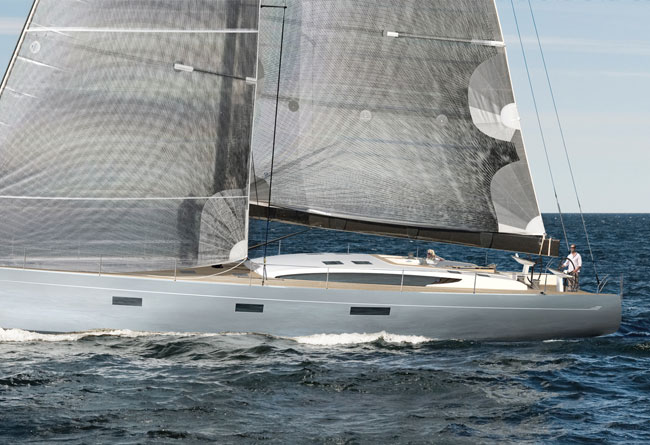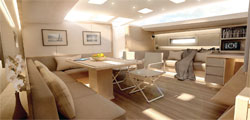

Best known these days for an astonishing output of fast and dramatic superyachts such as Pink Gin, Baltic Yachts are bringing that expertise and experience to bear on a new selection of 67ft semi-custom fast-cruisers…
In the boatbuilding business a good reputation is hard won and easily lost, and Baltic Yachts’ reputation is as solid as every boat it’s ever launched. It’s not a yard that has ever resorted to trumpet-blowing PR fanfare, it’s a yard that has, for 45 years, remained quietly focused on developing innovative techniques to build light, fast, impeccably finished boats from best-quality materials. The story began in Bosund, Finland, in 1973 with a C&C-designed 46ft cruiser-racer, the first of many from designers like Petersen, Judel/Vrolijk, S&S and Tripp. Today Baltic are best known for building custom superyachts like the 175ft Judel/Vrolijk sloop Pink Gin.
Baltic’s finger is for ever on the pulse of the yachting market and they have identified strong demand for a fast, easily handled bluewater family cruiser that will happily sail on in light airs when others are hoisting the iron jib. To create this semi-custom boat Baltic approached the team behind Pink Gin, Judel/Vrolijk and Design Unlimited.
‘Baltic wanted a 20.5m mould available so that they could deliver a semi-custom performance cruising concept at relatively short notice. That was the brief,’ says designer Rolf Vrolijk, ‘to build a boat with the quality of Baltic, with all the attention to detail and weight, making sure there’s enough volume available to have the interior configuration customers want and still deliver a higher level of performance for a cruiser. The main aim is comfortable, fast cruising in a range of different conditions.
‘We have worked on similar concepts before with Baltic, with the 66 and the 56, and they sold quite a lot of boats out of those moulds. The idea was to update the concept with a more modern type of hull and present options to the customers they have lined up – different deck layouts, several rigs and sailplans, three keel configurations, twin or single rudders. The concept boat is a completely composite carbon-fibre structure but the yard can build many different variations. The first boat will have a fibreglass outer skin with carbon structural reinforcement, others will push really hard on the carbon, so displacement will vary between 23.5 and 25 tonnes lightship. We had to make sure that the hull shape would tolerate slight variations in displacement.’
‘We didn’t want to go for the latest type of performance-oriented cruising boat – we’ve designed several boats that have narrow waterlines, which rely on more stability when the boat heels,’ he continues. ‘This is a more conservative approach. The boat already has good initial stability, with enough volume and enough beam aft to have quite an effective waterline length, and slightly more volume in the topsides forward to compensate. The volume distribution contributes to the directional stability, so she uses less power under autopilot. When heeled the boat has a very similar volume distribution. In the normal range of performance cruising, so zero to 20 or 22° of heel, the boat stays quite symmetrical – heeling doesn’t change the longitudinal trim a lot.’
‘We use our in-house CFD programs, which are linked to our in-house VPP programs, and we also work with the sail designers to get the correct sail force for our VPP programs,’ adds Vrolijk. There are three different rig and sailplans, but all are carbon with three tapered aerofoil spreaders, Nitronic 50 rod rigging, Park Avenue or V-booms and non-overlapping jibs for ease of handling. Mainsails will be either single-line slab or in-boom reefing.
‘One is a bluewater cruising rig, which doesn’t need reefing below 18-20kt of true wind speed, and we have standard and performance rigs. In terms of sail area, there’s a difference of around 10 per cent between them, about 30m2. The performance square-head main has 2-3 per cent more area in the main. It does involve running backstays – some people have no problem with that, others don’t want it at all.
‘We also have three different appendage configurations. The first boat will have a 3.9m telescopic keel and the second a 3.3m shallow-draft fixed keel, and then there is also a performance version with a 3.9m fixed keel. Within all these arrangements you can go for either the single or twin rudder configuration. For the telescopic and shallow-draft versions the twin rudder is the more logical choice, and on the high-performance version you have the single rudder. The displacement between the various appendage configurations varies by around 600-800kg.
‘There are several deck options. The standard one is the twin-wheel, open-transom aft cockpit arrangement with two banks of 24v-powered Harken 80.3 winches within reach of the helm and two Harken 60.3 halyard winches forward. In the past we have done centre cockpit and deckhouse versions of the 56 and 66, open or closed transoms, different deck lockers, and those are all options for the 67 too. Baltic offer a very individual semi-custom approach, which is popular because the normal market is not that flexible – very few yards can do that.’
The range of options Vrolijk outlines is staggering. Aren’t the engineering challenges insurmountable? ‘Not for a yard with the experience that Baltic have. They had to figure out how to accommodate the different interior layouts, mast positions and deck layouts within mould systems and structures without having to build new moulds every time. That’s the challenge, but in the long run it makes sense because they can produce better boats a lot faster and at a very reasonable price compared to a full custom build.’
While much of the focus is understandably on the semi-custom aspect of the Baltic 67 project, the yard has drawn up a comprehensive, sail-away standard spec that will save owners days of ticking option boxes. Highlighting a few at random, the standard specification comes with B&G radar, instruments and autopilot, four-blade Bruntons Autoprop, Northern Lights generator, Parker Racor fuel filters, Climma air-conditioning, Spectra watermaker, Mastervolt chargers – it even includes a boathook!

The challenge for Design Unlimited’s Mark Tucker was not just to design a range of interiors suitable for long-distance cruising. ‘Baltic came to us and said: “We want to develop a 67ft semi-custom cruiser, how can you add value to it?” So we really hooked back into their core values, to bring that heritage and DNA back into today’s market. We went to when Baltic originated to find what they were really about. Baltic wanted to create a boat that had that fundamental understanding.
‘The first thing was to work on the layouts to give different clients different options without having to significantly re-engineer the boat,’ Tucker continues. ‘A lot of thought went into platform design so we could swap things around. On the interior styling, first we looked at what we would call the “Baltic style” and then we developed a few other styles: from a typical Mediterranean light wood to a much more ‘outthere’ contemporary style. The other thing Baltic wanted was that we sit down with the owners and take it further in terms of colours, materials and timbers, but still keep the underlying architecture of the yacht intact, because that’s where they can save time, weight and development, and get the boat back to the right weight, which is what Baltic are all about.’
‘The result is definitely a more performance-oriented, bluewater, fast cruising boat,’ he adds. ‘She will sail beautifully and she will perform, and the first two clients have gone to Baltic very much for those reasons. The exterior styling has been developed to keep a little of the Baltic DNA, clean lines, low superstructure, and the owners were very much involved in that too. We love the style and the look of the boat but the challenge to make this a true Baltic product, to keep their core values of sailing, quality and performance, was not easy. We’re in fine tolerances all the way through, so the way it’s turned out I think is a big win.’
Baltic keep a detailed weight study, which includes LCG and VCG positions, and weigh the boat several times during the build. The build of hull no1 is a case study of Baltic’s laser-like focus on weight saving, as Joakim Kasslin, structural engineer at Baltic Yachts, explains. ‘We use a strong, airtight female mould that can withstand the 85- 90°C curing temperatures required by carbon epoxy Sprint laminates. The inner skin has woven rovings (0/90°) and biaxial (-45/ +45°) Sprint materials in monolithic areas, with vacuum-consolidated epoxy wet lay-up used for local reinforcement. She has a structural foam core in slamming areas vacuum-bonded for reliability. The outer skin is woven rovings and biaxial, again in carbon epoxy Sprint. We build the deck in the same way, in SAN foam core.’
‘For hull stiffness we add floors and longitudinal girders on the bottom and stringers on the sides, and the deck will have beam webs and longitudinal girders,’ adds Kasslin. ‘In high-stress areas we use unidirectional carbon. There are watertight bulkheads fore and aft, just ahead of the 3m tender garage, and the structural bulkheads are all fabricated on a vacuum table with unidirectional, woven and biaxial carbon Sprint on a machined Corecell foam core. Non-structural elements, and much of the joinery below, have 1.6mm wood veneers on a foam core. Everything is Sprint except the engine bed, for which we use E-glass on a high-density core to cut down on noise transmission.’
‘The keel fin is Duplex 1.4462 steel, epoxy-faired and painted, with a 3 per cent antimony lead bulb, and the owner has chosen the hydraulically lifting keel, which has a stroke of 1.4m inside the hull. The rudder is carbon, laid up in a specially strengthened mould to withstand the high pressure at which PVC foam is injected, and we have a chain and Vectran cable steering system driving an aluminium quadrant.’
She is not being built like your average 67ft yacht either, says Mark Tucker: ‘Baltic build every cabin as a module and drop it in so it’s not connected to the structure. It’s a lighter way of building boats because you’re not securing furniture with timber or extra composite.’
‘They’re bringing the best of their technology from the superyachts down to the 67ft level,’ says Tucker. ‘Not many builders do that. A lot of engineering thought and 3D modelling go into the process. These will be cracking boats.’
Click here for more information on Baltic Yachts »
We invite you to read on and find out for yourself why Seahorse is the most highly-rated source in the world for anyone who is serious about their racing.
To read on simply SIGN up NOW
Take advantage of our very best subscription offer or order a single copy of this issue of Seahorse.
Online at:
www.seahorse.co.uk/shop and use the code TECH20
Or for iPad simply download the Seahorse App at the iTunes store


